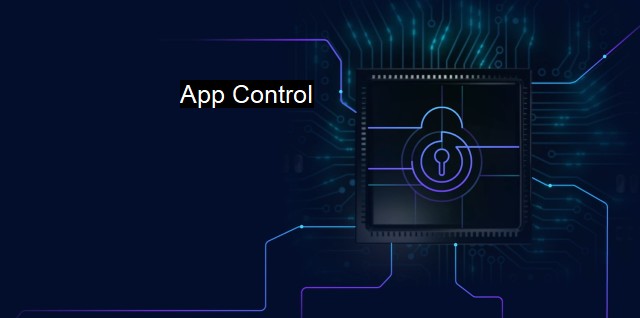What is App Control?
Empowering Device Security: Understanding App Control for Mobile Applications
App control, also referred to as application control or application whitelisting, is a fundamental security principle that focuses on preventing unauthorized execution of both malicious and non-malicious applications. It is a vital part of the overarching strategy in cybersecurity and fits into the broader endpoint security framework involving antivirus software, intrusion detection systems, firewalls, among others.App control works by only allowing specified applications to run on a system or network while blocking others that may be potentially harmful. It is based on the tried-and-true approach of compatibility and trust. Administrators compile a list of applications that they have tested, trusted, and deemed necessary for the business operations called the whitelist. Whenever an application tries to execute on a protected endpoint, app control checks if it is included in the whitelist before allowing it to run.
The implementation of app control is increasingly essential in the modern digital realm, characterized by savvy cyber criminals constantly deploying new and complex attacks. Traditional antivirus solutions use a blacklist approach, where they identify and block known threats. relying solely on this reactive approach doesn't defend against novel attacks. App control forms a necessary proactive line of defence, preventing breaches before they happen rather than dealing with consequences afterwards.
Traditional antivirus solutions need constant updating against the unending wave of new malware. Given the intensive and often time-consuming nature of this process, breaches can occur between update cycles. Contrastingly, app control complements this stance incorporating a "default-deny" posture. Unless an application is specified in the whitelist, it won’t be allowed to execute, ensuring neutralization of unauthorized scripts or retrieved software. Consequently, this mitigates the ‘window of vulnerability,' shielding businesses before a patch or new antivirus signature comes out.
Besides preventing anonymized malware and Zero-day exploits, app control can defend against other financial and IP data threats. Data exfiltration tools, crypto-mining, "living off the land" tools, and potentially unwanted programs (PUPs) can detrimentally impact organizations financially, legally, and reputationally. Since these programs may not be flagged by antivirus, app control gains considerable importance, ensuring only approved applications function, and risk is reduced to a minimum.
Despite its enormous potential and benefits, app control implementation has its challenges. Managing whitelist databases can become complex. Proper administration, continuous evaluation, and updating of whitelists become exhaustive, mainly if organizations rely on extensive application portfolios. Also, app control could lead to ‘overblocking,’ where legitimate and necessary software gets denied execution, causing operational disruptions.
The rise of sophisticated cyber-crimes calls for comprehensive security measures. Therefore, organizations often combine app control with other endpoint security controls like antivirus software, robust firewall settings, intrusion prevention or detection systems, and data loss prevention tools, among others. The multi-layered, integrated approach is generally more successful against advanced and consistent threats.
Although implementing an app control solution requires effort and skill, organizations are turning towards it as an essential approach for robust cybersecurity. Besides preventing potential cyber threats, it also promotes awareness and visibility into software environments, with audit trails of denied or allowed applications.
Technology leaders like Microsoft and other cybersecurity companies provide app control measures catered to business and individual needs. Ongoing technological advancements continue to introduce automated and intelligent app control strategies to make processes more straightforward. For instance, ‘dynamic app control,' where machine learning algorithm identifies and updates trustworthy applications automatically.
App control is an indispensable component of a modern cybersecurity posture, proactively defending against both known and unknown threats. Though it comes with its associated complexity, automation and integration with other endpoint deployments are aiding more straightforward and worry-less adoptions, leading towards safer conduct of business in the digital world.

App Control FAQs
What is app control in terms of cybersecurity and antivirus?
App control is a feature in cybersecurity and antivirus software that allows you to monitor and manage the applications on your device. This feature helps you to identify and block any malicious or suspicious applications that may compromise the security of your device.How does app control work?
App control works by analyzing the behavior of applications on your device and identifying any suspicious activities. It then alerts you to the presence of any malicious applications and provides you with options to block or remove them from your device.Do I need to enable app control on my antivirus software?
App control is usually enabled by default in antivirus software. However, it is always a good practice to verify that it is enabled and configured appropriately to ensure the highest level of protection for your device.Can app control prevent malware attacks?
Yes, app control can help prevent malware attacks by monitoring the behavior of applications on your device and identifying any suspicious activities. It can then alert you to the presence of any malicious applications and provide you with options to block or remove them, effectively preventing them from compromising the security of your device.| | A | | | B | | | C | | | D | | | E | | | F | | | G | | | H | | | I | | | J | | | K | | | L | | | M | |
| | N | | | O | | | P | | | Q | | | R | | | S | | | T | | | U | | | V | | | W | | | X | | | Y | | | Z | |
| | 1 | | | 2 | | | 3 | | | 4 | | | 7 | | | 8 | | |||||||